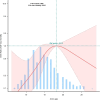Anion gap associated with 28-days all-cause mortality in Acute cholangitis patients admitted to the intensive care unit in MIMIC-IV database: a retrospective cohort study
- PMID: 40486199
- PMCID: PMC12142621
- DOI: 10.3389/fmed.2025.1591096
Anion gap associated with 28-days all-cause mortality in Acute cholangitis patients admitted to the intensive care unit in MIMIC-IV database: a retrospective cohort study
Abstract
Background: Acute cholangitis, characterized by infection of the bile duct, represents a significant clinical challenge due to its association with heightened morbidity and mortality rates. This condition often culminates in severe complications, including sepsis and multi-organ failure, ultimately leading to increased healthcare burdens. The anion gap (AG) serves as a potential biomarker for systemic inflammation and has been proposed as a prognostic indicator. To evaluate its efficacy in predicting patient outcomes, a closer examination of AG levels and their relationship to mortality in acute cholangitis patients is warranted.
Methods: This study employed a retrospective cohort design, utilizing data gleaned from the MIMIC-IV database. A total of 489 patients admitted to the Intensive Care Unit (ICU) with acute cholangitis were analyzed, and participants were stratified into quartiles according to their serum AG levels. Mortality rates, as well as the incidence of acute kidney injury (AKI) and sepsis, were meticulously recorded and analyzed to establish any significant correlations with AG levels.
Results: The findings indicated a stark association between elevated AG quartiles and increased rates of AKI, sepsis, and overall mortality. Specifically, the 28-day mortality rate escalated markedly from 8.1% in the lowest AG quartile to 30.9% in the highest quartile (p < 0.001). Furthermore, multivariate logistic regression analysis revealed that each unit increase in AG was associated with a 13% enhancement in mortality risk (OR 1.13, 95%CI 1.03-1.124, p = 0.010). An inverted J-shaped correlation between AG levels and mortality was also identified, indicating a potential inflection point at 18.13 mEq/L.
Conclusion: This study elucidates the significant role of AG as a prognostic marker in critically ill patients with acute cholangitis, emphasizing its potential utility in guiding early intervention strategies to mitigate mortality risks. Future research endeavors should aim to explore the therapeutic implications of managing AG levels and assess their relevance in wider clinical contexts to enhance patient outcomes.
Keywords: 28-days all-cause mortality; MIMIC-IV database; acute cholangitis; anion gap (AG); intensive care unit (ICU).
Copyright © 2025 Huang, Yin and Han.
Conflict of interest statement
The authors declare that the research was conducted in the absence of any commercial or financial relationships that could be construed as a potential conflict of interest.
Figures
Similar articles
-
Association between the anion-gap and 28-day mortality in critically ill adult patients with sepsis: A retrospective cohort study.Medicine (Baltimore). 2024 Jul 26;103(30):e39029. doi: 10.1097/MD.0000000000039029. Medicine (Baltimore). 2024. PMID: 39058855 Free PMC article.
-
Predictive value of the serum anion gap for 28-day in-hospital all-cause mortality in sepsis patients with acute kidney injury: a retrospective analysis of the MIMIC-IV database.Ann Transl Med. 2022 Dec;10(24):1373. doi: 10.21037/atm-22-5916. Ann Transl Med. 2022. PMID: 36660703 Free PMC article.
-
Albumin corrected anion gap and clinical outcomes in elderly patients with acute kidney injury caused or accompanied by sepsis: a MIMIC-IV retrospective study.Eur J Med Res. 2025 Jan 7;30(1):11. doi: 10.1186/s40001-024-02238-z. Eur J Med Res. 2025. PMID: 39773636 Free PMC article.
-
Association Between High Serum Anion Gap and All-Cause Mortality in Non-Traumatic Subarachnoid Hemorrhage: A Retrospective Analysis of the MIMIC-IV Database.Front Neurol. 2022 Jul 12;13:922099. doi: 10.3389/fneur.2022.922099. eCollection 2022. Front Neurol. 2022. PMID: 35903118 Free PMC article.
-
Correlation between baseline anion gap and early acute kidney injury in patients with acute pancreatitis in the intensive care unit: A single-center retrospective cohort study.PLoS One. 2025 Feb 11;20(2):e0315386. doi: 10.1371/journal.pone.0315386. eCollection 2025. PLoS One. 2025. PMID: 39932897 Free PMC article.
References
LinkOut - more resources
Full Text Sources
Miscellaneous




